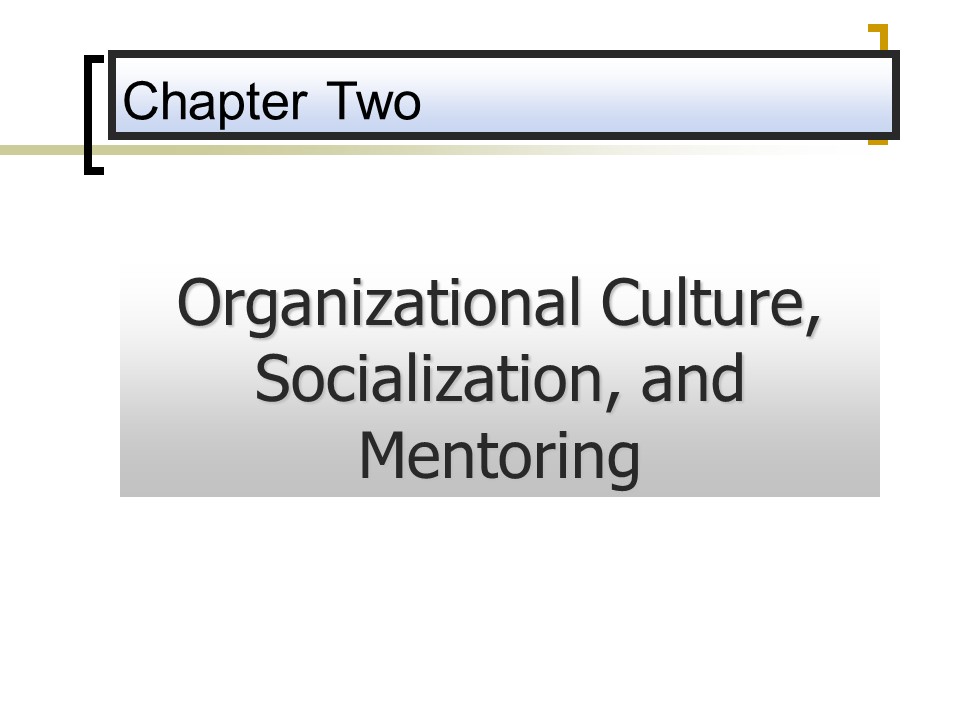Chapter Two - PowerPoint PPT Presentation
Title:
Chapter Two
Description:
Chapter Two Organizational Culture, Socialization, and Mentoring – PowerPoint PPT presentation
Number of Views:161
Avg rating:3.0/5.0
Title: Chapter Two
1
Chapter Two
Organizational Culture, Socialization, and
Mentoring
2
Chapter Two Outline
2-1a
- Foundation of Organizational Culture
- Layers of Organizational Culture
- Four Functions of Organizational Culture
- Types of Organizational Culture
- Outcomes Associated with Organizational Culture
- How Cultures are Embedded in Organizations
- Embedding Organizational Culture Through
Socialization Processes and Mentoring. - A Three-Phase Model of Organizational
Socialization - Practical Application of Socialization Research
- Attitudes
- Using Mentoring to Your Advantage
3
Organizational Culture Is
- The set of shared, taken-for-granted implicit
assumptions that a group holds and that
determines how it perceives, thinks about, and
reacts to its various environments. - - Edgar Schein
4
Conceptual Framework for Understanding
Organizational Culture
- Figure 2-1 (p41) shows the building blocks of
organizational culture and its outcomes
5
The Layers of Organizational Culture
Source Adapted from E H Schein, Organizational
Culture and Leadership, 2nd ed (San Francisco
Jossey-Bass, 1992), p 17.
6
Four Functions of Organizational Culture
7
Types of Organizational Culture
Type of Normative Culture
Belief Characteristics Constructive
Achievement Goal and achievement
oriented
Constructive Self-actualizing
Value self-development and
creativity
Constructive Humanistic-
Participative, employee encouraging
centered, and supportive
Constructive Affiliative High
priority on constructive
interpersonal relationships,
and focus on work group
satisfaction
8
Types of Organizational Culture (cont)
Type of Normative Culture
Belief Characteristics Passive-
Approval Avoid conflict, strive to be
likedDefensive by
others, and approval oriented
Passive- Conventional Conservative,
bureaucratic, andDefensive people follow
the rules
Passive- Dependent Nonparticipative,
centralizedDefensive decision making, and
employees do what they are told
Passive- Avoidance Negative reward
system andDefensive avoid accountability
9
Types of Organizational Culture (cont)
Type of Normative Culture
Belief Characteristics Aggressive-
Oppositional Confrontation and
negativismDefensive rewarded
Aggressive- Power
Nonparticipative, take charge of Defensive
subordinates and responsive to
superiors
Aggressive- Competitive
Winning is valued and a win-Defensive
lose approach is used.
Aggressive- Perfectionistic
Perfectionistic, persistent, and Defensive
hard-working
10
Embedding Organizational Culture
- Formal statements of organizational philosophy,
mission, vision, values, and materials used for
recruiting, selection and socialization - The design of physical space, work environments,
and buildings - Slogans, language, acronyms, and sayings
- Deliberate role modeling, training programs,
teaching and coaching by managers and supervisors - Explicit rewards, status symbols (e.g.,
titles),and promotion criteria - Stories, legends, and myths about key people and
events
11
Embedding Organizational Culture (cont)
- The organizational activities, processes, or
outcomes that leaders pay attention to, measure,
and control - Leader reactions to critical incidents and
organizational crises - The workflow and organizational structure
- Organizational systems and procedures
- Organizational goals and the associated criteria
used for recruitment, selection, development,
promotion, layoffs, and retirement of people
12
A Model of Organizational Socialization
Perceptual and Social Processes
Phases
1. Anticipatory socializationLearning that
occursprior to joining the organization
- Anticipating realities about the organization
and the new job - Anticipating organizations need for ones
skills and abilities - Anticipating organizations sensitivity to
ones needs and values
13
A Model of Organizational Socialization (cont.)
Perceptual and Social Processes
Phases
- Managing lifestyle- versus-work conflicts
- Managing intergroup role conflicts
- Seeking role definition and clarity
- Becoming familiar with task and group
dynamics
2. Encounter Values, skills and attitudes
start to shift as new recruit discovers what
theorganization is trulylike
14
A Model of Organizational Socialization (cont.)
Perceptual and Social Processes
Phases
3. Change and acquisition Recruit masters
skills and roles and adjusts to workgroups
values and norms
- Competing role demands are resolved
- Critical tasks are mastered
- Group norms and values are internalized
15
A Model of Organizational Socialization
(continued)
16
Have you Been Adequately Socialized?
- Have you been adequately socialized in this
College?
- Does your school adequately socialize employees?
- How do high levels of socialization impact a new
students satisfaction? Explain.
- What is a new students role in the
socialization process?
17
Mentoring
The process of forming and maintaining intensive
and lasting developmental relationships between a
variety of developers (i.e., people who provide
career and psychosocial support) and a junior
person (the protégé, if male or protégée if
female).
- Functions of Mentoring
- Career Functions- Sponsorship- Exposure and
visibility- Coaching- Protection- Challenging
assignments - Psychosocial Functions- Role modeling-
Acceptance and confirmation- Counseling-
Friendship
18
Developmental Networks Associated with Mentoring
Developmental relationship strength
Strong ties
Weak ties
D2
D2
Low range
D1
D1
P
P
Receptive
Traditional
Developmental relationship diversity
D1
D2
D1
D2
High range
P
P
D3
D4
D3
D4
Opportunistic
Entrepreneurial
Source M Higgins and K Kram, Reconceptualizing
Mentoring at Work A Developmental Network
Perspective, Academy of Management Review, April
2001, p. 270
Key D, developer P, protégé.
19
Building an Effective Mentoring Network
- Become the perfect protégé
- Engage in 360-degree networking
- Commit to assessing, building, and adjusting the
mentor network - Develop diverse, synergistic connections
- Realize that change is inevitable































